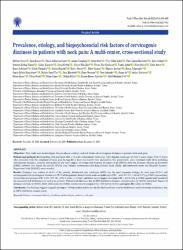Prevalence, etiology, and biopsychosocial risk factors of cervicogenic dizziness in patients with neck pain: A multi-center, cross-sectional study

View/
Access
info:eu-repo/semantics/openAccessDate
2021Author
Vural, MeltemKaran, Ayşe
Gezer, Ilknur Albayrak
Kurt, Emine Eda
Erhan, Belgin
Alptekin, Hasan Kerem
Ural, Halil Ibrahim
Metadata
Show full item recordCitation
Vural, M., Karan, A., Gezer, İ. A., Çalışkan, A., Atar, S., Aydın, F. Y., ... & Ural, H. I. (2021). Prevalence, etiology, and biopsychosocial risk factors of cervicogenic dizziness in patients with neck pain: A multi-center, cross-sectional study. Turkish journal of physical medicine and rehabilitation, 67(4), 399.Abstract
Objectives: This study aims to investigate the prevalence, etiology, and risk factors of cervicogenic dizziness in patients with neck pain. Patients and methods: Between June 2016 and April 2018, a total of 2,361 patients (526 males, 1,835 females; mean age: 45.0±13.3 years; range, 18 to 75 years) who presented with the complaint of neck pain lasting for at least one month were included in this prospective, cross-sectional study. Data including concomitant dizziness, severity, and quality of life (QoL) impact of vertigo (via Numeric Dizziness Scale [NDS]), QoL (via Dizziness Handicap Inventory [DHI]), mobility (via Timed Up-and-Go [TUG] test), balance performance [via Berg Balance Scale [BBS]), and emotional status (via Hospital Anxiety- Depression Scale [HADS]) were recorded. Results: Dizziness was evident in 40.1% of the patients. Myofascial pain syndrome (MPS) was the most common etiology for neck pain (58.5%) and accompanied with cervicogenic dizziness in 59.7% of the patients. Female versus male sex (odds ratio [OR]: 1.641, 95% CI: 1.241 to 2.171, p=0.001), housewifery versus other occupations (OR: 1.285, 95% CI: 1.006 to 1.642, p=0.045), and lower versus higher education (OR: 1.649-2.564, p[removed]
Source
Turkish Journal of Physical Medicine and RehabilitationVolume
67Issue
4Collections
- Yayın Koleksiyonu [33]

















